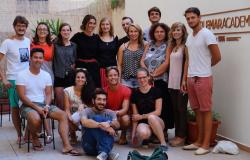One of the largest religious festivals in the world takes place the first weeks of February in the Sicilian city of Catania when it honors its patron saint, Sant’Agata. Some estimate that up to a million people line the streets to honor this martyred young woman with Sicilian roots.
Saint Agatha was a teenager from a wealthy family when she was approached by a Roman prefect. She refused his advances, and he had her tortured in many ways, including the severing of her breasts, which is why Saint Agatha is often depicted holding her amputated breasts on a platter. Indeed, she is the patron saint of bell-founders because of the shape of the severed breasts.
Saint Agatha was then sentenced to be burned at the stake, but an earthquake saved her from that fate; instead, she was sent to prison where St. Peter the Apostle appeared to her, healed her wounds, and filled her dreary prison cell with light.
Saint Agatha died in prison around 250 A.D. when she was just 15 years old. In the 11th century, her body was found to be “incorrupt,” i.e., showing no major signs of decomposition, and parts of her incorrupt body still exist today.
The Festa di Sant’Agata in Catania starts with Mass at dawn on 3 February; then a statue of Saint Agatha holding her relics is placed on a 40,000 pound silver fercolo, or carriage, which is pulled up Via San Giuliano by 5,000 men. The celebrations continue into Saint Agatha’s feast day of 5 February.
Here are some sights and sounds of the festa; especially moving are the cries of the faithful and the nuns chanting at dawn:
Along with Catania and bell-founders, Saint Agatha is also the patron saint of San Marino, Malta, bakers, nurses, firefighters, breast cancer patients, and rape and torture victims.












